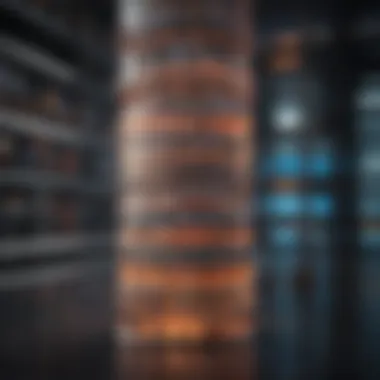Creating a cDNA Library: An In-Depth Exploration


Intro
The construction of a complementary DNA (cDNA) library serves as a pivotal method in molecular biology. It enables researchers to study gene expression in various organisms and conditions. cDNA libraries allow for the analysis of messenger RNA (mRNA) transcripts, providing insights into gene function and regulation. Understanding how these libraries are created and employed can enrich the knowledge of both students and experienced researchers alike.
Research Overview
Creating a cDNA library involves several methodical steps, each contributing to the quality and usability of the library. This section summarizes the critical aspects of this process.
Summary of Key Findings
The essential steps in cDNA library construction include:
- Isolation of mRNA: The first step involves isolating the mRNA from the cells of interest. This is crucial as it serves as the template for synthesizing the complementary DNA. Techniques like affinity chromatography are often employed to ensure purity.
- Synthesis of cDNA: Reverse transcription is performed using the isolated mRNA. This step defines the core of cDNA library construction. Enzymes, such as reverse transcriptase, are utilized for synthesizing the cDNA strand.
- Cloning the cDNA: The synthesized cDNA must be inserted into a suitable vector, allowing for replication within host cells. Various vectors can be used, depending on the desired application.
These steps collectively yield a comprehensive cDNA library that can be used for various applications, from gene cloning to expression analysis. The importance of each of these steps cannot be overstated, as they lay the groundwork for the success of downstream applications.
Importance of the Research in Its Respective Field
cDNA libraries have revolutionized our understanding of genetics, providing critical insights into gene expression patterns across different conditions. In research and biotechnology, these libraries play an integral role in:
- Identifying Gene Function: By comparing expression levels of genes under various circumstances, researchers can draw conclusions about their roles and importance.
- Studying Disease Mechanisms: cDNA libraries allow for the exploration of gene expression in diseased tissues, aiding in the discovery of potential biomarkers and therapeutic targets.
- Developing Biotechnological Applications: The information gleaned from cDNA libraries can lead to innovations in genetic engineering, synthetic biology, and personalized medicine.
In summary, cDNA libraries are essential tools that leverage gene expression data to fuel advancements in many scientific domains.
Methodology
The methodology of creating a cDNA library is intricate and involves multiple stages that must be executed with precision.
Description of the Experimental or Analytical Methods Used
- mRNA Isolation: High-quality mRNA is isolated using methods such as:
- Reverse Transcription: Using reverse transcriptase, the mRNA serves as a template to synthesize cDNA. This step is crucial because it determines the fidelity and completeness of the cDNA.
- Amplification and Cloning: The constructed cDNA is amplified using PCR techniques. The resulting fragments are ligated into plasmid vectors for transformation into host cells, such as E. coli
- Screening and Analysis: The clones are screened for insert presence and integrity. Techniques like restriction digestion and gel electrophoresis can confirm successful cloning.
- Poly-A tail selection
- Column chromatography
Sampling Criteria and Data Collection Techniques
The sampling criteria involve selecting appropriate cell types based on the research goals. Data collected during the construction of the cDNA library includes:
- Quantity and Quality of Isolated mRNA: Ensuring high purity levels for effectiveness in reverse transcription.
- cDNA Yield and Quality Assessment: Determining the efficiency of the conversion from mRNA to cDNA.
Intro to cDNA Libraries
cDNA libraries play a crucial role in molecular biology, serving as indispensable tools for the exploration of gene expression. These libraries facilitate a deeper understanding of genetic mechanisms by allowing researchers to clone and analyze the complementary DNA derived from mRNA transcripts. In essence, cDNA libraries contain a representation of all the genes expressed in a particular cell type or tissue. The value of understanding where and when genes are active cannot be overstated as it lays the groundwork for further studies in genetics, disease mechanisms, and potential therapeutic interventions.
Definition and Purpose
Complementary DNA, or cDNA, is synthesized from messenger RNA (mRNA) through a process called reverse transcription. This transformation process results in the creation of DNA that is complementary to the original mRNA molecule. The main purpose of cDNA libraries is to provide a snapshot of the gene expression profile in different cells or conditions. These libraries allow for the identification of actively expressed genes in specific situations, paving the way for the study of genetic regulation in health and disease.
cDNA libraries are utilized not just for analyzing gene expression, but also for developing recombinant DNA technology applications. They can serve as templates for cloning genes, producing proteins, or generating specific antibodies. Additionally, they enable researchers to explore splice variants and post-transcriptional modifications that influence gene function.
Historical Context
The creation of cDNA libraries emerged alongside advancements in molecular biology techniques in the late 20th century. It was during the 1970s that the enzyme reverse transcriptase was discovered, allowing scientists to convert RNA into cDNA. The initial breakthroughs came when researchers had the ability to amplify these cDNA sequences, leading to the development of comprehensive cDNA libraries.
Over the years, the methods for constructing cDNA libraries have evolved significantly. Initially, techniques involved cloning cDNA into plasmids for bacterial propagation. Now, advancements in technology and bioinformatics have facilitated more efficient approaches, such as high-throughput sequencing. The implications of these developments extend beyond basic research, influencing fields like genomics, transcriptomics, and biotechnology more broadly.
In summary, the significance of cDNA libraries cannot be overlooked. They are not only vital for understanding the complexities of gene expression but also anchor the foundation for explorations in medical research, genetic engineering, and therapeutic drug development.
Fundamental Principles of cDNA Synthesis
The synthesis of complementary DNA (cDNA) is a critical process in molecular biology, as it lays the foundation for the creation of a cDNA library. Understanding the fundamental principles of cDNA synthesis is essential for researchers and students alike, as it helps in grasping how gene expression can be analyzed and harnessed. Key elements include the transcription process and the role of reverse transcriptase, both of which facilitate the production of cDNA from mRNA templates. This section will elucidate these principles and discuss their importance in the context of cDNA library construction.


Transcription Process Overview
Transcription is the first step in gene expression, where DNA is copied into RNA. This process is crucial because it allows genetic information to be transmitted from DNA to RNA, and ultimately, to proteins. The transcription process generally involves three main stages: initiation, elongation, and termination.
- Initiation: In this stage, the enzyme RNA polymerase binds to a specific region of the DNA called the promoter. This interaction unwinds the DNA helix, exposing the template strand for RNA synthesis.
- Elongation: Here, RNA polymerase moves along the template strand, adding nucleotides according to the base-pairing rules. The RNA strand grows as nucleotides are consecutively added, forming a complementary copy of the DNA template strand.
- Termination: The elongation phase continues until RNA polymerase encounters a termination signal in the DNA sequence. This signal prompts the enzyme to detach from the RNA strand, which then undergoes further processing to form mature mRNA.
The importance of transcription in cDNA synthesis cannot be overstated. It determines the variety and quantity of mRNA that will be converted into cDNA. Factors influencing transcription efficiency include the availability of transcription factors, the structure of chromatin, and the nature of the regulatory elements present.
Reverse Transcriptase Function
Reverse transcriptase is an enzyme vital for cDNA synthesis. It catalyzes the transcription of RNA into cDNA, essentially reversing the usual flow of genetic information. This enzyme is derived primarily from retroviruses and is instrumental in converting the mRNA obtained during the transcription process into complementary DNA.
The function of reverse transcriptase involves several steps:
- Binding to RNA: The enzyme first binds to the mRNA template. A specific primer is often required to successfully initiate the synthesis of cDNA.
- Synthesis of cDNA: As reverse transcriptase moves along the RNA template, it synthesizes a strand of cDNA. The base-pairing rules govern this procedure, ensuring that nucleotides align correctly (A with T, C with G).
- RNA Degradation: After cDNA synthesis, the RNA template is degraded by the enzyme itself or other RNA-specific nucleases. This allows for the formation of a single-stranded cDNA molecule.
- Second Strand Synthesis: In many cDNA library protocols, the resulting single-stranded cDNA can be converted into double-stranded cDNA. This occurs through the action of DNA polymerase, completing the transformation of RNA to cDNA.
Reverse transcriptase is not only fundamental for cDNA synthesis but also impacts the quality and efficiency of the resulting cDNA. Different reverse transcriptases exhibit varying properties, such as fidelity and reaction conditions. Thus, selecting the right enzyme is crucial for successful library creation.
"Understanding the role of reverse transcriptase and the transcription process is key to mastering cDNA library construction and its applications in genomic research."
In summary, grasping the fundamental principles of cDNA synthesis is imperative for anyone involved in molecular biology and genetic research. It provides essential insights into how genes are expressed and how these expressions can be studied and manipulated for various applications.
Materials Required for cDNA Library Construction
Creating a cDNA library effectively requires a selection of materials essential to achieve accurate and representative cDNA synthesis. Understanding the specific needs in this process can significantly influence the quality of the resulting library. Properly sourced materials not only enhance the efficiency of the protocol but also ensure the integrity of the cDNA produced. The following discussion highlights crucial aspects of source material selection and essential reagents and equipment.
Source Material Selection
The choice of source material is a fundamental step in cDNA library construction. This decision dictates the type of transcripts that can be studied and can influence experimental outcomes.
- Tissue Type: Different tissues express varying genes. For instance, neuronal tissue will yield transcripts relevant to brain functions, while liver tissue will provide data related to metabolic pathways. Therefore, selecting the relevant tissue depending on the hypothesis of the study is vital.
- Developmental Stage: The developmental stage of the organism can also affect gene expression. For instance, embryonic tissues might provide insights into developmental biology that adult tissues may not. This consideration ensures that the library reflects the biological question at hand.
- Health Status: The health status of the organism can influence the expression levels of various genes. Healthy versus diseased samples will yield different transcriptomes. This factor needs careful consideration to tailor the library for specific research objectives.
Choosing the right source material can be the differentiation between successful experiments and inconclusive results.
Essential Reagents and Equipment
The effective synthesis of cDNA requires various reagents and equipment critical for the experimental setup. These components, each playing a distinct role, must be of high quality to achieve reliable results.
- Reagents:
- Equipment:
- Oligo(dT) Primer: Essential for the specific priming of mRNA during reverse transcription.
- Reverse Transcriptase: An enzyme that synthesizes cDNA from the mRNA template. Choosing appropriate reverse transcriptase significantly impacts the efficiency of cDNA synthesis.
- dNTPs (Deoxynucleotide Triphosphates): These are the building blocks for synthesizing cDNA. They must be of high purity to prevent incorporation errors.
- RNase Inhibitors: To protect RNA from degradation during the cDNA synthesis process, these inhibitors are crucial, especially in the presence of RNases.
- Thermal Cycler: Required for controlling temperature settings during cDNA synthesis and amplification. It is essential for the precise execution of PCR cycles.
- Microcentrifuge: To quickly mix and prepare small volumes of samples. Necessary for various steps in the cDNA library construction.
- Electrophoresis System: Important for assessing the integrity and size of cDNA, confirming successful synthesis.
Utilization of these reagents and equipment optimally contributes to the overall quality of the cDNA library. A thoughtful approach to material selection along with proper reagents and equipment enhances library construction, leading to insightful genomic analyses.
Properly selected materials and high-quality reagents are key to successful cDNA library construction.
Step-by-Step Protocol for cDNA Library Creation
The creation of a cDNA library is a systematically orchestrated process. This section explores the essential steps involved, highlighting the technical intricacies and considerations that impact the outcomes. By understanding the step-by-step protocol, researchers can ensure the reliability and accuracy of the resulting libraries, ultimately enhancing the quality of their experiments and data interpretations.
Isolating mRNA
The first crucial step in cDNA library construction is the isolation of mRNA from the chosen biological sample. This process is fundamental because the quality and purity of isolated mRNA directly influence the integrity of the eventual cDNA. Typically, mRNA is extracted using a lysis buffer that facilitates the release of RNA from cells while protecting it from degradation. The inclusion of extraction kits, such as the Qiagen RNeasy Mini Kit, simplifies the process.
"High-quality mRNA isolation is essential for successful cDNA synthesis. Poor-quality RNA can lead to suboptimal yields and biased results."
Once isolated, it is important to assess mRNA concentration and purity using spectrophotometry. The ratio of absorbance at 260 nm and 280 nm provides insights into protein contamination. The final step involves storing the mRNA at a low temperature to preserve its integrity until the next phase.
cDNA Synthesis
Following mRNA isolation, the next phase is the synthesis of complementary DNA (cDNA). This process involves the reverse transcription of mRNA, employing reverse transcriptase enzyme. The choice of reverse transcriptase plays a critical role; for instance, enzymes like M-MLV or SuperScript II are popular due to their efficiency in synthesizing cDNA from mRNA templates.


The reaction mixture typically contains the mRNA, reverse transcriptase, primers, dNTPs, and a buffer system. By incubating this mixture at specific temperatures, the enzyme synthesizes cDNA strands complementary to the mRNA. This results in a double-stranded cDNA, which is critical for downstream applications.
Paying attention to the reaction conditions is vital. Temperature and time should be optimized based on the chosen reverse transcriptase to attain maximum yield and minimal errors in cDNA synthesis.
Vector Preparation
Once cDNA synthesis is complete, vector preparation is the next step. Vectors are plasmids that accommodate the insert of the cDNA. Vector choice is primarily determined by the eventual use of the cDNA library, whether for expression studies or cloning.
Vectors such as the pGEM-T Easy Vector are commonly used. Preparation involves linearizing the vector with appropriate restriction enzymes, which creates sticky or blunt ends for cDNA ligation. Ensuring the competence of the vector is crucial, as ligation efficiency influences library quality. Once ready, the vector is purified and quantified before proceeding.
Transformation and Plating
The final step in cDNA library creation involves the transformation of competent bacterial cells with the ligated vector-cDNA complex. Commonly, E. coli strains are utilized. The transformation process generally employs methods like heat shock or electroporation to introduce the recombinant DNA into the bacterial cells.
Subsequently, transformed cells are plated onto selective growth media containing antibiotics that allow for the selection of successfully transformed colonies. Overnight incubation leads to the formation of colonies, each harboring a unique cDNA insert. This step is essential as it sets the groundwork for library complexity, with diverse inserts leading to a more comprehensive representation of the original mRNA population.
In summary, successfully creating a cDNA library requires meticulous execution of each step. Attention to detail in mRNA isolation, cDNA synthesis, vector preparation, and transformation can dramatically impact the utility of the library in gene expression studies and other applications.
Quality Control Measures
Quality control measures play a pivotal role in the successful construction of cDNA libraries. Without proper quality control, the entire process may yield inaccuracies and limitations that undermine the library's potential. Researchers must prioritize these measures to ensure that the cDNA library produced is representative, reliable, and suitable for subsequent analyses and applications. This section will delve into two significant aspects of quality control: assessing cDNA integrity and evaluating library complexity.
Assessing cDNA Integrity
Assessing cDNA integrity is crucial for confirming that the synthesized cDNA accurately reflects the original mRNA transcripts from which it was derived. Several methods can evaluate cDNA integrity, including electrophoresis and quantitative PCR (qPCR).
- Electrophoresis allows visual confirmation of the cDNA size distribution. A sharp and distinct band represents pure and intact cDNA. Conversely, a smear may indicate degradation, suggesting that careful handling during synthesis is required.
- Quantitative PCR provides insights into the amplification efficiency of the cDNA. By validating specific target genes, researchers can determine whether the cDNA behaves as expected during amplification processes. The qPCR can also help quantify the cDNA, ensuring adequate amounts are available for downstream applications.
The assessment should occur at various stages of the cDNA library construction to ensure proper quality is maintained.
Evaluating Library Complexity
Evaluating the complexity of a cDNA library is essential for understanding its depth and representation of the original transcriptome. A complex library contains diverse cDNA species that reflect the variety of transcripts from the source material, which increases the likelihood of capturing low abundance transcripts crucial for specific studies.
- Mapping to Reference Genomes: One approach to evaluating complexity involves sequencing the cDNA and mapping the resulting sequences to a reference genome. This data helps determine how many unique transcripts are present and how they compare to what is expected.
- Clonal Analysis: Counting the number of colonies formed when the cDNA is transformed into host cells provides another way to measure library complexity. More colonies suggest a more heterogeneous library, whereas fewer colonies may indicate bias in the synthesis process.
Implementing these quality control measures ensures researchers can trust the data generated from cDNA libraries and apply these findings effectively in gene expression analysis, protein production, and functional genomics. The implications of achieving a high-quality cDNA library go beyond immediate use; it enhances the potential for future research endeavors.
Applications of cDNA Libraries
The significance of cDNA libraries in modern molecular biology cannot be overstated. These libraries play critical roles in various applications that extend into gene expression research, protein production, and functional genomics. Understanding how cDNA libraries are applied can significantly inform researchers' approach to experimental design and data interpretation. Each application displays unique aspects that contribute to the advancements in biotechnology and genetics.
Gene Expression Analysis
Gene expression analysis is a fundamental application of cDNA libraries. Researchers utilize these libraries to study gene activity across different biological conditions or developmental stages. The ability to analyze mRNA transcripts offers insights into which genes are actively expressed and under what circumstances.
cDNA libraries allow for comparative gene expression studies. By constructing libraries from various tissues or specific conditions, scientists can identify specific gene expression profiles. This data is particularly important in the fields of cancer research, where the identification of overexpressed or underexpressed genes can lead to better therapeutic targets.
Additionally, techniques such as quantitative PCR can be employed on these cDNA libraries to measure expression levels. Understanding gene expression patterns aids in the elucidation of biological mechanisms and pathways, enhancing the overall knowledge of gene functionality.
Protein Production
Producing proteins from cloned genes is another pivotal utilization of cDNA libraries. By inserting cDNA clones into expression vectors, researchers can induce the cells to express specific proteins. This is especially relevant in the production of recombinant proteins, which are used in therapeutics, diagnostics, and biotechnology.
For instance, the production of insulin, which is crucial for diabetes management, often relies on cDNA technology to produce the hormone in bacterial systems. The use of cDNA libraries facilitates the screening of potential proteins necessary for various applications quickly and effectively.
Keeping in mind that protein yield can be affected by various factors, including vector choice and host organism, selecting the right conditions for expression is vital. This adaptability ensures that cDNA libraries remain a relevant tool in protein engineering and production.
Functional Genomics
Functional genomics is yet another critical area utilizing cDNA libraries. This application encompasses assessing the roles and interactions of genes at a functional level. cDNA libraries provide researchers with tools to manipulate gene function through knockdown or knockout studies, helping to ascertain gene functions in vivo.


Moreover, cDNA libraries empower scientists to perform high-throughput screenings that can analyze gene interactions and regulatory networks comprehensively. This is invaluable for understanding complex biological systems and diseases at a molecular level. By systematically exploring how different genes function together, researchers can pinpoint potential biomarkers for disease or novel therapeutic targets.
"cDNA libraries are instrumental in bridging the gap between genome sequencing data and functional understanding of genes."
In summary, the applications of cDNA libraries are vast and varied, making them indispensable in modern biological research. Their contributions to gene expression analysis, protein production, and functional genomics underscore their integral role in navigating the complexities of genetics and molecular biology.
Challenges in cDNA Library Construction
The advancement of cDNA libraries has propelled scientific progress across various disciplines. However, the process of constructing these libraries is not without its challenges. Addressing the difficulties in cDNA library construction is crucial to improve the outcomes and reliability of research. Understanding these challenges can also help researchers refine their methodologies.
Technical Challenges
Creating a cDNA library involves a series of intricate technical steps. Each step requires precision and expertise. Common technical challenges include:
- mRNA Isolation: The quality of extracted mRNA is vital. Contamination or degradation of mRNA can lead to incomplete or biased libraries.
- Reverse Transcription Efficiency: The process relies heavily on reverse transcriptase, the enzyme responsible for synthesizing cDNA from mRNA. Variability in enzyme efficiency can result in unequal representation of transcripts.
- Vector Construction: Cloning the cDNA into vectors is another technical hurdle. Insufficient or improper ligation can disrupt the cloning process and yield non-viable vectors.
To address these issues, researchers may rely on optimized protocols and high-quality reagents. Moreover, using robust quality control measures at each step is essential to ensure the integrity and utility of the cDNA library.
Biological Variability
Biological variability can significantly impact cDNA library construction. This variability arises from multiple sources:
- Sample Diversity: Different sources of RNA may express genes at varying levels. For instance, cDNA libraries derived from different tissues or developmental stages can reflect distinct gene expression profiles.
- Environmental Factors: Changes in environmental conditions, such as temperature or stress, can influence gene expression. This variability can be critical, especially when constructing libraries from samples exposed to differing conditions.
- Technical Replicates: Even minor inconsistencies in handling and processing can give rise to biological noise.
To manage biological variability, researchers should standardize sample collection and processing methods. Additionally, performing multiple technical replicates can provide a more reliable representation of the underlying biological system.
"Understanding and addressing both technical and biological challenges in cDNA library construction is essential for achieving high-quality genomic data."
Future Directions in cDNA Library Development
The evolution of cDNA libraries stands as a testament to the remarkable advancements in terms of biotechnology and genomics. As researchers continue to delve deeper into the complexities of gene expression, understanding the future directions in cDNA library development is essential. These forward-looking perspectives will provide insights into how technology can enhance research methodologies and outcomes, shaping the landscape of biotechnology research.
Advancements in Technology
Innovation plays a crucial role in shaping the future of cDNA libraries. We are witnessing a swift pace of development in various technologies that can significantly improve the construction, quality, and application of cDNA libraries. Key aspects of these advancements include:
- Automated Platforms: Automation enhances efficiency in cDNA library construction, reducing variability and human error. Automated liquid handling systems can streamline the process of mRNA isolation and cDNA synthesis.
- Enhanced Reverse Transcriptases: Newer enzyme formulations have been developed that increase the efficiency of reverse transcription. These enhancements result in higher yields of cDNA, facilitating better representation of the original mRNA.
- Increased Throughput: High-throughput technologies enable large-scale cDNA library creation. These methods allow researchers to analyze more transcripts in less time, broadening the spectrum of gene expression studies.
- Bioinformatics Integration: With the rise of computational biology, integrating bioinformatics tools into cDNA library projects enables better data analysis. Researchers can glean more understandable insights from sequencing data, enhancing the interpretations of gene functions.
These technological advancements not only bolster experimental methods but also allow for more intricate explorations into cellular functions and pathways.
Integration with Next-Generation Sequencing
The amalgamation of cDNA libraries with next-generation sequencing (NGS) marks a pivotal shift in genomic research. NGS provides a means to sequence cDNA libraries rapidly, facilitating a thorough study of transcriptomes. The benefits of this integration include:
- High Resolution: NGS enables researchers to capture both known and novel transcripts at an unprecedented scale. The detailed insights gained allow for a more comprehensive understanding of gene expression profiles.
- Quantitative Analysis: Through NGS, quantification of mRNA levels becomes possible. This capability ensures that variances in gene expression can be accurately compared across different conditions, enhancing the reliability of results.
- Insight into Rare Transcripts: NGS has the potential to uncover low-abundance transcripts that may play critical roles in cellular functions. Detecting these rare transcripts can lead to groundbreaking discoveries in understanding disease mechanisms.
- Multi-Dimensional Data Generation: By combining data from multiple samples and conditions, researchers can generate multi-faceted views of gene activity. This comprehensive approach paves the way for personalized medicine and tailored therapeutic strategies.
"The integration of next-generation sequencing with cDNA libraries is revolutionizing the understanding of genetic expression. It opens avenues for discoveries previously thought unreachable."
In summary, examining future directions in cDNA library development emphasizes the transformative potential of technology and its implications for research. As advancements continue, the applications of cDNA libraries promise to foster groundbreaking insights across various domains, enhancing our comprehension of biology and the mechanisms underlying it.
End
The conclusion of this article serves as a pivotal point for understanding the creation and implications of cDNA libraries in molecular biology. The significance of cDNA libraries cannot be overstated. They are essential tools that facilitate the study of gene expression patterns, ultimately leading to deeper insights into biological systems.
Summary of Key Points
In summary, this article has covered various aspects of cDNA library creation. Key points include:
- The definition and purpose of cDNA libraries in research.
- Fundamental principles of cDNA synthesis and the role of reverse transcriptase.
- A comprehensive list of materials needed for library construction.
- Detailed step-by-step protocols, from mRNA isolation to vector preparation and transformation.
- Importance of quality control measures to ensure cDNA library integrity.
- Diverse applications, such as gene expression analysis and functional genomics.
- Challenges encountered during the construction and how to mitigate them.
- Insights into future directions, including technological advancements and integration with next-generation sequencing.
Each section contributes to a complete understanding of how cDNA libraries serve as a foundation in genetic research and biotechnology.
Implications for Future Research
The implications for future research stemming from this article are profound. As technologies advance, the potential for cDNA libraries to assist in uncovering new gene functions is significant. Enhanced methodologies may lead to finer resolution in analyzing gene expression, enabling researchers to address complex biological questions. The integration of cDNA libraries with next-generation sequencing techniques promises to streamline processes and yield richer datasets.
Moreover, there is a growing emphasis on the application of cDNA libraries in personalized medicine. Understanding the variability in gene expression across different individuals could lead to tailored therapeutic approaches. The continuous evolution of this field highlights the necessity for ongoing research that builds on the foundational knowledge provided in this article.
"The future of genetic research and biotechnology is largely intertwined with innovations in cDNA library technologies. Successful exploration in these areas opens doors to unprecedented discoveries."







